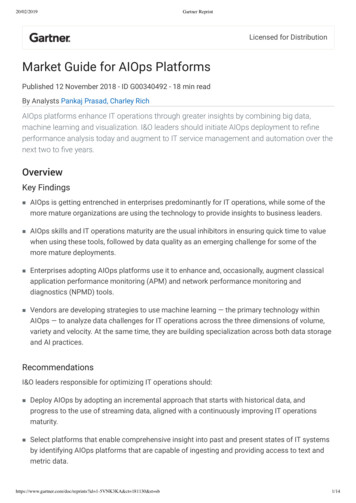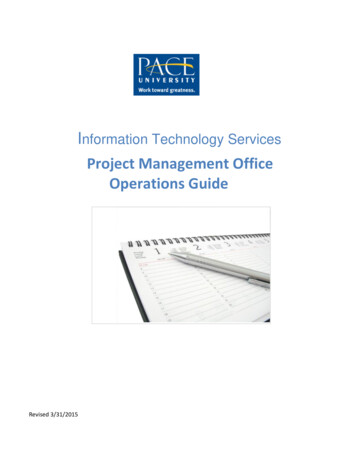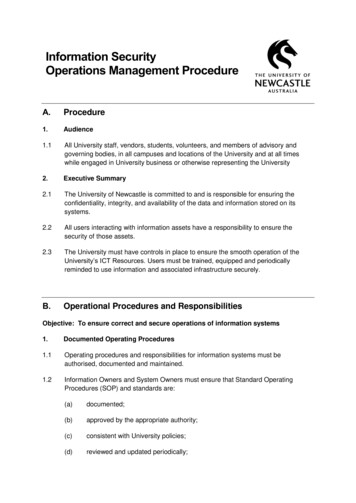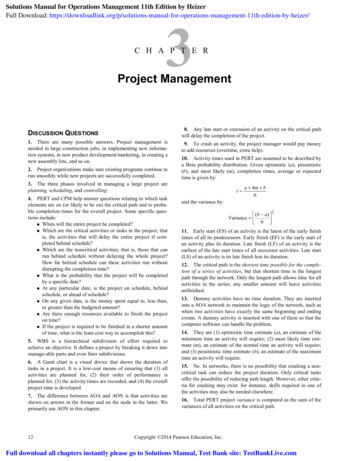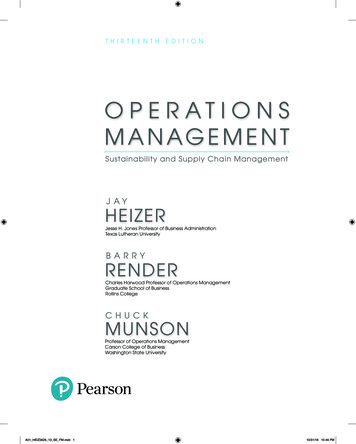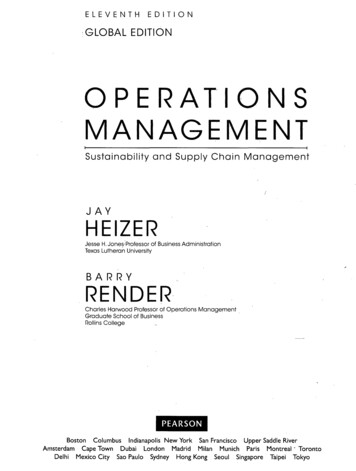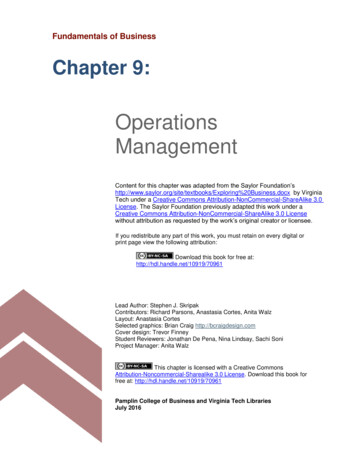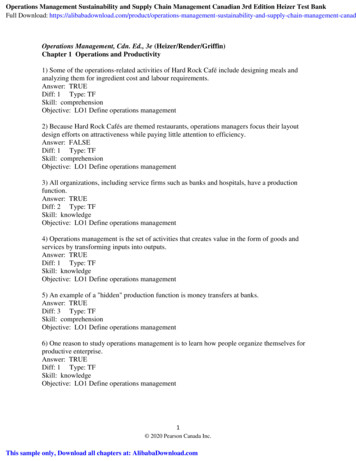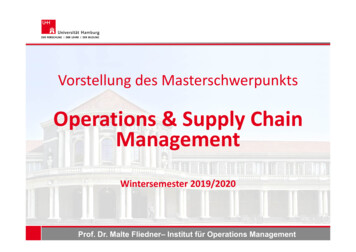
Transcription
eBookSuperchargeOperationsManagementwith AIOps
IT operations teams facea growing challenge.As IT environments grow in scale and complexity, it’s notenough for organizations to monitor infrastructure andapplications for performance and availability. They mustalso manage and optimize the business service as a whole toprovide the agility, speed, and scalability required by DevOpsinitiatives, new technologies, lift-and-shift cloud migrations,and cloud-native applications.“Complex, distributed applications that employcontainers, on-prem and cloud resources,orchestration tools, and microservices aremore challenging to manage. They generatelarge volumes of operations data, and whenperformance problems occur, they issue acascading series of events, making it difficult foroperations professionals to pinpoint the cause.”**451 Research, ‘Strong adoption ofAI & ML monitoring tools is drivenby tech leaders’, October 2020To fully leverage AIOps, lookbeyond monitoring for a holisticmanagement solution.2
Speed, data volume, and complexity:A challenging combinationSimply put, IT organizations are facing a firehose of data — far too much to analyze quickly and then respond in time.Trouble signals are being drowned out by too much noise and typically lack the context necessary to determine the rootcause. As a result, organizations experience service degradation, availability issues, prolonged mean-time-to-repair (MTTR),and enhanced risk for missing service level agreements.To cope with increased data volumes and IT environment complexity, operations teams often acquire IT monitoring toolsin a tactical and fragmented way, with less than satisfactory results:MULTIPLE SINGLE-POINT TOOLS:Many organizations load up on monitoring tools, which results in higher costs and a lackof integration that complicates rather than improves end-to-end visibility.MONITORING-ONLY STRATEGY:Organizations that have modernized their monitoring tools can still be slow to respond to issues because they lackearly visibility into anomalies and root causes, and are overwhelmed by noise created by multiple uncorrelated events.MANUAL ROOT CAUSE ANALYSIS:Monitoring alone does little to assist in the slow, methodical task of uncovering and resolving theroot cause of performance issues, which delays resolution, wastes skilled labor, and increases MTTR.3
“74% of incidents are detected bycustomers before IT is aware of them.”*“Average MTTR per incident is 3 hours and 7minutes. 72% of that time is spent identifyingthe root cause of the problem.”*“Cloud-native technologies often requireusers to update their monitoring tools,and the tools that serve cloud nativeenvironments often use AI/ML.”***Digital Enterprise Journal, September 2019**451 Research, ‘Strong adoption of AI & ML monitoring tools isdriven by tech leaders’, October 20204
How AIOps supercharges operations managementEnd-to-end monitoring across complex, hybrid environments with containerized microservices is necessary but is not up to the taskwithout AIOps. IT Operations teams must adopt an integrated monitoring, event management, and remediation strategy driven byintelligence, machine learning (ML) and AI-powered data analytics across their entire IT environment.In addition, they must build AIOps into digital and cloud transformation processes as they aim to maintain the highest visibility,performance, and availability levels possible. To achieve this goal, an effective AIOps strategy must solve for these challenges: UNDETECTED ANOMALIES:Setting manual thresholds to detect anomalous activity can lead to falsealarms or overlooked complex multivariate anomalies. EVENT NOISE:As IT environments grow in size and complexity, it becomes increasingly difficult to seethrough the symptoms of a problem to accurately identify the source. CONTEXT & CORRELATION:Multiple events are often related to a single root cause, requiring IT staff to spend timesifting through these events to drill down to the root cause, a labor-intensive process. INTEROPERABILITY:There are many monitoring tools out there, so you need open integrations and aunified platform that can leverage data from across your environments to obtainintelligent operations management recommendations.Operations teams must deploy machine learning and analytics as part ofan AIOps strategy to manage the increasing volume, variety, and velocity ofdata across an increasingly hybrid, complex, and fast-moving IT landscape.“By 2022, DevOpsteams that leverageAIOps platforms to deploy,monitor and supportapplications will increasedelivery cadence by 20%.”**Gartner, ‘Augment Decision Making in DevOpsUsing AI Techniques,’ June 20195
The buildingblocks of AIOpsHow can you get from monitoring to the full-fledged promiseof AI-driven operations management and performanceoptimization? Your solution should provide these capabilities: Service-centric monitoring ML-driven anomaly detection Advanced log analytics Policy-based, automated event management AI-driven, service-centric probable cause analysis Open integrations with third-party solutions for maximum visibility and context Dynamic service models Multiple data sources Reporting and easy-to-use, customizable dashboardsIT Operations teams must adopta comprehensive operationsmanagement strategy driven byintelligence, ML, and advanced analyticsacross their entire IT environment.Look for:A single monitoring solution that acts as a‘manager of managers,’ which consolidates thirdparty monitoring and event data, to provide aunified view of complex IT infrastructureElastic, containerized microservicesarchitecture that enables enterprise scalability,performance, and availability for any on-prem,hybrid, or cloud-based environmentSaaS deployment, which enables rapidonboarding and the ability to manage complex,dynamic workloadsLeading-edge AIOps and machine learningtechniques, which trigger events and notificationsbefore thresholds are breachedAdvanced analytics capabilities that havethe ability to manage and process the everincreasing volume, variety, and velocity of datafrom multiple sources6
ML-driven anomaly detectionYour solution should be smart enough to learn the vital signs of a healthysystem and detect anomalies wherever they occur to Predict and proactively uncover issues beforethey cause service degradation or interruptionRecognize univariate and complex multivariateanomalies across configuration itemsThe smarter your anomaly detectionbecomes, the more proactive your teamcan be to capture performance issuesbefore they disrupt services.7
Policy-based automated event managementManual rules-based event management is time-consuming and prone to oversights and errors. Your AIOps solutionshould provide automated event management based on analytics and the data governance policies you’ve set. This offersyour team these benefits:CONTEXTRather than receiving indecipherable errormessages and URLs, the event can specifyissues and locations in plain language.EVENT CORRELATIONAND NOISE REDUCTIONYour solution should be able to correlateamong multiple events to generate a higherlevel event, minimizing noise.AUTOMATIONPolicy-based event management can generatea plain-language trouble ticket to a help solvea problem affecting a complex, multi-stepbusiness process.Connect your automated event management solution withprobable cause analysis to your service desk to provide contextfor help desk personnel to increase efficiency and reduce MTTR.8
AI-driven, service-centricprobable cause analysisThe holy grail of AIOps is to bring AI to bear on very large numbers of events,analyze them, and determine the most likely root cause(s) of a problem.Here’s how AI-driven analytics and automation saves time and resources:1.The system reviews data collected across all sources and sees through event noise2.It analyzes events that have come in, including factors such as timing, location,anomalies, services affected, and more.3.It learns how the infrastructure is configured and the relationships betweenservers, applications, and data.4.It provides the IT team a recommendation for the most likely probable cause.5.In seconds, the IT team can focus its attention on the likeliest solution.Probable cause analysis provides proactive,automated determination of root causeacross business services to cut through thenoise and reduce MTTR.9
The bad old daysWhile users are experiencing downtimeor performance issues, you’re Pulling the team away from its other work Investigating the large numbers of events showingup on your dashboard Looking into the metrics generating those events Referencing a topology view to try tounderstand dependencies Scratching your head Moving onto the next event until you ultimatelyfind the one that really matters10
Open integrationOpen integration is a key capability of AIOps, allowing it topull data from multiple solutions, including third-party tools,for analysis and decision-making. Ingest metric events and typology from a wide range of sources viaREST API out of the box. Consolidate data and create context-aware analysis. Provide a software development kit to support intelligent, openintegrations from any third-party source.Find a “manager of managers”capable of consolidating and analyzingmonitoring data no matter the source.4 types of data for analyticsThe AIOps model ingests and consolidates datafrom all these sources, no matter what monitoringtool was used to detect them.METRICSEVENTSLOGSTOPOLOGIES11
Dynamic service modelingMaintaining service models can be a time-consuming and resourceintensive process, especially given the rate at which IT changes. Dynamicservice modeling helps you avoid physically maintaining a service modelPull discovery data and adding metrics, events, logs, and topology.Ingest information from aross your environment.Get AI-driven discovery for all CIs andthe relationships between them.Feed information to an operations managementplatform for use with probable cause analysis andother capabilities.12
The BMC Helix Operations Management advantageBMC Helix Operations Management uses predictive capabilities to improve the performance andavailability of IT services across multi-cloud, hybrid, and on-premises environments proactively. AUTOMATED EVENT NOISE REDUCTION:Use ML and analytics to identify operational issues quickly by reducingevent noise up to 90%. INTELLIGENT ANOMALY DETECTION:Use multivariate or univariate anomaly detection to trigger eventsand notifications based on metrics behaving abnormally. AUTOMATED EVENT MANAGEMENT:Easily create and deploy customized policies to manage and controlevents and service impacts and perform event analytics. SERVICE-CENTRIC PROBABLE CAUSE ANALYSIS:Reduce MTTR by viewing the most likely sources of aproblem and obtain a full, actionable analysis. OPEN INTEGRATIONS:Leverage dynamic servicemodels and apply AIOpsto enhance anomalydetection and probablecause analysis anddetermine service impacts.Use out-of-the-box adapters and REST APIs for policy-driven datacollection, and ingestion of topologies from third-party solutions. BMC HELIX PLATFORM:Unified, open platform for cross-domain visibility, operability,and AI-driven automated actions and workflows.13
The BMC Helix Platform connectsoperations and service teams and unifiesBMC Helix Operations Management with:BMC Helix Discovery: to generate detailed CI datasetsand topologies across complex IT environments.BMC Helix Continuous Optimization: to align ITresources with business service demands.BMC Helix Cloud Cost: to optimize cloud resourcecosts, eliminating wasted spend and budget over-runs.BMC Helix ITSM: to deliver dramaticimprovements in service desk efficiency usingintelligence and predictive capabilities.14
Leading analysts agree:BMC is a leaderThe judgements are inBMC earns high ranking among Infrastructure and Operations(I&O) solution providers on a consistent basis and acrossmultiple dimensions.Find out why BMC ranks so highlyTo learn more, download the full analyst reports Gartner Magic Quadrantfor ITSM Tools, October 2020 EMA Radar Reports:AIOps, Q3 2020Gartner Magic Quadrant, October, 2020In Gartner’s Magic Quadrant for IT Service Management Tools,BMC was categorized as a leader, with the highest ranking incompleteness of vision among the 11 ranked providers thanksto its broad IT operations management portfolio, flexibledeployment options, and advanced I&O use case maturity.EMA Radar Report: AIOps, Q3 2020Enterprise Management Assoiates (EMA) scored BMCat the top of the charts for Busines Impact and BusinessAlignment use-case categories in EMA’s recent AIOps Radarreport. According to the report, BMC “offers a rich variety ofautomation options that are well evolved, well integrated, andcentral to its vision of the Autonomous Digital Enterprise.”15
Compare BMC HelixOperations ManagementCAPABILITYBMC HELIX OPERATIONSMANAGEMENTAIOps and machine learning Anomaly detection (Univariate, Multivariate) Behavioral learning Monitoring and event management External event ingestion Event noise reduction Proactive alerts and notifications Agent-based/agent-less collection Event analytics including clustering Elastic scalibility Containerized architecture External data ingestion Multi-tenancy Probable cause analysis BMC understands yourjourney towards theadoption of AIOpsThrough BMC Helix Operations Managementand complementary products across the BMCportfolio, we can help you achieve the essentialbenefits of IT operations management. RAPID DEPLOYMENT:Containerized, microservices architecture with SaaSbased deployment enables fast time to value for anycomplex IT infrastructure REDUCED MTTR:Leading-edge AIOps and machine learning technologiesproactively detect and analyze events INCREASED PRODUCTIVITY:Deep insights into complex infrastructures enable Cloud andOperations teams to quickly pinpoint and prevent issues ENHANCED BUSINESS CONTINUITY:Flexible scalability for managing complex, dynamic workloadsContinue your explorationContact us for a detailed demonstration of what BMC HelixOperations Management can do for you.16
About BMCBMC delivers software, services, and expertise to help more than 10,000 customers, including 92% of the Forbes Global 100, meet escalating digital demands andmaximize IT innovation. From mainframe to mobile multi-cloud and beyond, our solutions empower enterprises of every size and industry to run and reinvent theirbusiness with efficiency, security, and momentum for the future.Run and Reinventwww.bmc.comBMC, the BMC logo, and BMC’s other product names are the exclusive properties of BMC Software, Inc. or its affiliates, are registered or pending registration with the U.S. Patentand Trademark Office, and may be registered or pending registration in other countries. All other trademarks or registered trademarks are the property of their respective owners. Copyright 2021 BMC Software, Inc.17
Monitoring alone does little to assist in the slow, methodical task of uncovering and resolving the . from all these sources, no matter what monitoring tool was used to detect them. Dynamic service modeling 12 Maintaining service models can be a time-consuming and resource- . The
